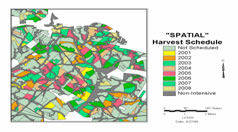
Harvest Scheduling and Forest Planning
Overview
Forest planning has become increasingly complex over the past few decades. What has traditionally been known as harvest scheduling was primarily concerned with wood and cash flows only (timber management). This has evolved into a comprehensive forest planning exercise involving many non-timber resources including:
- Wildlife Habitat
- Wetlands / Riparian Areas
- Cultural Resources
- Rural - Urban Interfaces
- Scenic Areas
- Forest Health
- Sustainability
- Recreation
- Forest Certification Standards
The regulatory environment is constantly changing and becoming more restrictive on the types and levels of activities allowed on forest land. The need for maximizing the economic outputs from the forest must be carefully balanced with the ecological values inherent on a given piece of property. FORSight's experts combine an array of skills and experience with state-of-the-art harvest scheduling tools to lend support for strategic and tactical forest planning decisions. FORSight's toolset includes the widely-used Remsoft Spatial Planning System. In fact, two of our harvest scheduling experts have been developing harvest scheduling models with Woodstock longer than anyone in the industry. That's just part of the reason FORSight is now a Remsoft Consulting Partner.
Clients rely on our analyses for:
- Optimizing wood and/or cash flows
- Improving operating results
- Valuing and/or optimizing portfolios
- Loan servicing/covenant compliance
- Evaluating investment opportunities
- Determining regional wood supplies
We enable clients to view a multitude of forest management options and arrive at plans that best suit their specific needs.
Good planning always costs less than good reacting.
-- John Capozzi
Strategic Forest Planning
Strategic planning focuses on the long-term. Significant consideration is given to the questions of when and how much? These plans identify sustainable harvest levels and silvicultural regimes that best meet strategic forest objectives. For these reasons, strategic planning can be accomplished at lower resolution and detail than tactical or operational planning. Some characteristics of strategic planning include:
- Consideration of the forest as a whole
- Long planning horizons (~2 rotations)
- Determines "sustainable" harvest levels over time
- Incorporates real operational & policy constraints
- Incorporates the biological potential of the forest (forest biometrics) and costs and revenues/prices information (economics)
Tactical Forest Planning
Once the strategic plan has been developed, it must then be allocated spatially. Tactical plans of this nature require higher levels of resolution and detail. The goal of tactical planning is to produce a spatially feasible and sustainable plan that can be implemented on-the-ground.

Strategic planning and tactical planning are commonly linked together in a hierarchical planning process. This ensures that the tactical and operational plans still meet the overall forest-wide objectives and come as close as possible to the optimum financial solution.
FORSight has considerable experience in the development of forest plans and harvest schedules for forest products companies, timberland investment management companies and federal agencies. To date we have completed plans on over 10 million acres of forestland throughout the U.S. and Canada.
Contact us today to learn how we can assist you in your forest planning efforts.
|

